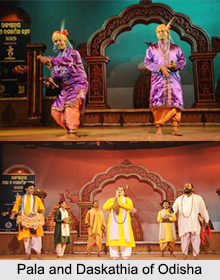 Troupe songs of Orissa are a particular interpretative song genre of the state. Troupes essentially mean groups of touring singers and actors, and these troupes go around the state performing their arts for the folk audience. Pala and the Daskathia are the two most important types of Troupe songs in Orissa. The troupes consist of 5-6 members each. Normally all of them are male although recently all-female troupes also have come up. Pala and Daskathia have gone a long way in bringing about an appreciation of the folk arts.
Troupe songs of Orissa are a particular interpretative song genre of the state. Troupes essentially mean groups of touring singers and actors, and these troupes go around the state performing their arts for the folk audience. Pala and the Daskathia are the two most important types of Troupe songs in Orissa. The troupes consist of 5-6 members each. Normally all of them are male although recently all-female troupes also have come up. Pala and Daskathia have gone a long way in bringing about an appreciation of the folk arts.
Pala
Pala is a hybrid form of folk music. It is closely associated with the worship of Satyapir which started in 17th century after the advent of the Mohammedan rulers. Satyapir is the combination of Satyanarayan of Hindus and Pir of Mohammedans. This Puja combines both Hindu as well as Muslim rituals.
The Pala is a group or ballad song. After the Puja, a Pala is sung by a group of singers and musicians. Generally, one lead singer with five followers performs the Pala before the audience. Accompaniments like Mridanga, Gini, Tala and Cymbals are used. The lead singer is called Gayak who enters with a Chamar (a sacred fan usually made of the hair of Chamari cow) in his hand. Besides this Gayak, there is a Sripalia who is the chief assistant to the Gayak. There are other Palias and the Bayakas. They narrate stories from the Indian Puranas and Kavyas. They quote extensively from various Sastras, Puranas and Kavyas both in Oriya language as well as Sanskrit language. They explain, explicate, analyse and interpret the quotations they use wherever necessary. They use both prose and song. The Palias occasionally create humour by telling jokes or deliberately misinterpreting the quotations. They perform either standing or sitting. The Gayak should possess a sharp memory, musical abilities, presence of mind, and clear voice. He should be well versed both in Sanskrit and Oriya literature.
Sometimes, competitions of two groups are also arranged by villagers. The two Pala groups try their best to prove their command over language and literature.
Daskathia
Like Pala, Daksathia too is a special form of interpretative song genre of Orissa. It is otherwise called Ramtali. The accompaniment is a two-piece wooden percussion played by hands. The clappers are held in the left hand with the fore finger in between the two to keep them apart and are played with the right hand with the thumb pressing the upper one with a jerk to strike the clapper below. While singing, the singers keep the time-beats with the clappers and produce various unique rhythms or sounds of percussion.
The Daksathia performance consists of only two people. The singer is called Gayak and his assistant is called Palia. Palia makes humour and enlivens the performance. The latter always asks questions concerning the theme in prose dialogue and the main singer answers through the songs. They simultaneously sing and dance and create a dramatic atmosphere. Daskathia mostly uses material from the Ramayana, Mahabharata and from medieval Oriya compositions ranging from fourteenth to eighteenth century. This form is mostly popular in south Orissa, where almost all well-known Oriya poets of medieval period were born. Like Pala this is also an interpretative musical exercise where the lead singer simplifies, explains or interprets classical song compositions for the folk audience.



















